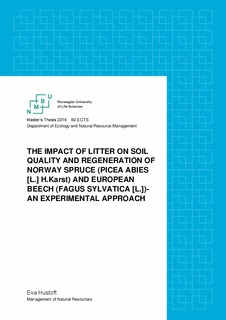The impact of litter on soil quality and regeneration of Norway spruce (Picea abies (L.) H. Karst) and European beech (Fagus sylvatica (L.) : an experimental approach
Master thesis
Permanent lenke
http://hdl.handle.net/11250/2403207Utgivelsesdato
2016-08-31Metadata
Vis full innførselSamlinger
- Master's theses (INA) [593]
Sammendrag
During the next decades, the climate in Scandinavia is predicted to become wetter and warmer. This change will alter the ecosystems, and implies a possible transformation from Norway spruce (Picea abies) to European beech (Fagus sylvatica) forests in the Southeast of Norway. Several factors will affect the success of these two species, and among these are the impacts of litter on soil quality and regeneration.
This study represents a litter moving and seed sowing experiment conducted at Brånakollene Nature Reserve, an area where spruce - and beech forest meet. The experiment consisted of 20 research plots; 10 in beech forest and 10 in spruce forest. Each research plot consisted of four 50 x 150 cm subplots with assigned treatments litter removed, control, transplanted spruce litter and transplanted beech litter. The treatment plots were sown with beech seeds and spruce seeds. Samples from both plant tissue and soil were collected four months later. Due to a total predation of beech seeds, the results on plant tissue contain only material from spruce plants. The collected samples were used to make a suggestion to the impact of litter on different response variables. The response variables in plant tissue were: number of recruited plants, average plant weight, carbon (C), nitrogen (N) and C:N ratio. The response variables we looked at in soil were: pH, C, N and C:N ratio.
I found that forest type had an effect on all response variables, in both plant tissue and soil. Litter treatment showed an impact on regeneration through a significant effect on the number of recruited plants, but no influences on the other response variables in plant tissue were discovered. The results also suggest that soil chemistry is not significantly affected by litter in the short-term perspective provided in this study.
In this research, I show how different litter manipulations can affect regeneration of spruce, and how this might affect interspecific competition. Man regner med at det blir våtere og varmere i Skandinavia over de neste tiårene. Dette vil
endre økosystemene, og innebærer en mulig transformasjon av skogdominansen fra Norsk
gran (Picea abies) til Europeisk bøk (Fagus sylvatica) i sør-øst Norge. Flere faktorer vil
påvirke suksessen til de to artene, og blant disse er påvirkninger fra strøfall på jordkvalitet og
regenerasjon.
Dette studiet presenterer et eksperiment med flytting av strø og såing av frø utført ved
Brånakollene naturreservat, et område hvor gran- og bøkeskog møtes. Her samlet vi inn
prøver fra både plantemateriale og jord for å kunne framlegge et forslag om strøfallets
påvirkning på ulike responsvariabler.
Eksperimentet besto av 20 plots; 10 i bøkeskogen og 10 i granskogen. Hver plot bestod av fire
50 x 150 cm subplots med tilhørende behandlinger strø fjernet, kontroll, granstrøbehandling
og bøkestrøbehandling. Subplotsene ble sådd med bøkefrø og granfrø. Prøver fra både
plantemateriale og jord ble samlet inn fire måneder seinere. Grunnet totalpredasjon av
bøkefrøene, inneholder resultatene fra plantene kun materiale fra gran. Prøvematerialet ble
brukt til å si noe om strøfallets påvirkning på de ulike responsvariablene. Responsvariablene i
plantematerialet var: antall spirede planter, gjennomsnittlig plantevekt, karbon (C), nitrogen
(N) og C:N ratio. I jordmaterialet så vi på pH, C, N og C:N ratio.
Jeg fant at skogtype hadde en påvirkning på alle responsvariablene, i både planter og jord.
Strøbehandling hadde påvirkning på regenerering gjennom en signifikant effekt på antall
spirede planter, men ingen påvirkninger av strøfall ble funnet på noen av de andre
planteresponsvariablene. Resultatene fra studiet foreslår også at jordkjemien ikke blir påvirket
i signifikant grad av strøfall i et korttidsperspektiv. I dette studiet viser jeg hvordan ulike manipuleringer med strøfall kan påvirke regenerering av
gran, og hvordan dette muligens kan påvirke interspesifikke konkurranseforhold.
